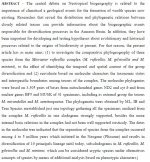Soares, Leonardo; Bates, John; Carneiro, Lincoln; Santos, Marcos ; Aleixo, Alexandre. Molecular systematics, biogeography, and taxonomy of forest-falcons in the
Micrastur ruficollis species complex (Aves: Falconidae). Journal of Avian Biology, Recently accepted article.
Abstract:
We gathered molecular data to assess phylogenetic and phylogeographic patterns for widespread lineages of Neotropical forest falcons in the genus Micrastur to: (1) investigate the comparative phylogeography of four species from the M. ruficollis complex (M. ruficollis, M. gilvicollis, M. plumbeus and M. mintoni), to identify the temporal and spatial context of the group’s diversification; and (2) to reevaluate, based on molecular characters, the taxonomic status and interspecific boundaries within this complex. Molecular phylogenies were based on sequences of the mitochondrial genes ND2 and Cyt b and the nuclear genes BF5 and MUSK from 119 specimens, including M. mirandollei and M. semitorquatus as outgroups. The phylogenetic trees obtained by BI and a Species Tree analysis recovered the monophyly of currently accepted species belonging to the M. ruficollis complex. The dates in our tree indicate that the separation of species within the complex occurred 2 to 4 million years ago, initiating during the Neogene (Pliocene). However, when compared to most such widely distributed Neotropical lineages, the diversification within the M. ruficollis complex appears more recent (i.e, centered in the Late Pleistocene). Our results demonstrate the existence of eleven geographic lineages (subclades) in M. ruficollis, M. gilvicollis, and M. mintoni, which differ genetically from each other and therefore can be interpreted as distinct evolutionary lineages and possibly separate species under lineage-based species concepts. However, BPP results failed to recognize with strong statistical support any of these subclades as distinct species. Distinct subclades in the M. ruficollis complex are limited by the principal tributaries of the Amazon River and the Andes, suggesting that these modern barriers limit gene flow and thereby could have promoted differentiation mostly during the Pleistocene. However, our results indicate disparate responses to individual barriers across subclades, supporting lineage-specific histories throughout the Neotropics.





